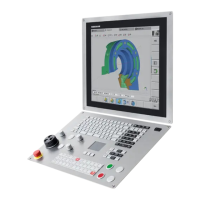DIN/ISO programming | Programming variables
4
462
HEIDENHAIN | User's Manual smart.Turn and DIN Programming | 12/2017
If the variables are to be retained in the memory
when the control is switched off, this feature must
be activated by the machine tool builder in the
CfgNcPgmParState machine parameter (no 200700).
If this feature is not activated, the variables values will
always be "zero" after power-up.
You can also use variables to program M functions.
String variables
The TIME function writes the date or time to a string variable.
This variable can then be engraved using an engraving cycle.
Contents of variables can be converted to string variables and
added together.
Example: date and time
. . .
N.. #x1=TIME("D.M.YY")
Date in string variable #x1
N.. #x2=TIME("h:m:s")
Time in string variable #x2
. . .
Example: conversion to a string variable
. . .
N.. #x1=STRING(#i21)
Convert variable #i21 to string variable #x1
N.. #x2=TIME("h:m:s")+STRING(#i21)
Add time and variable #i21
. . .
Machine dimensions
#m1(n) .. #m99(n): n is the designation of the axis (X, Z, Y)
for which the machine dimension is to be read or written. The
variable calculation uses the table mach_dim.hmd. Simulation:
During the startup of the control, the table mach_dim.hmd is
read by the simulation. The simulation function now uses the
table of the simulation
Example: Machine dimensions
. . .
N.. G1 X(#m1(X)*2)
N.. G1 Z#m3(Z)
N.. #m4(Z)=350
. . .

